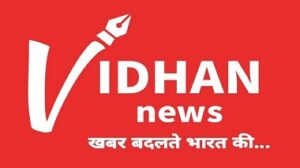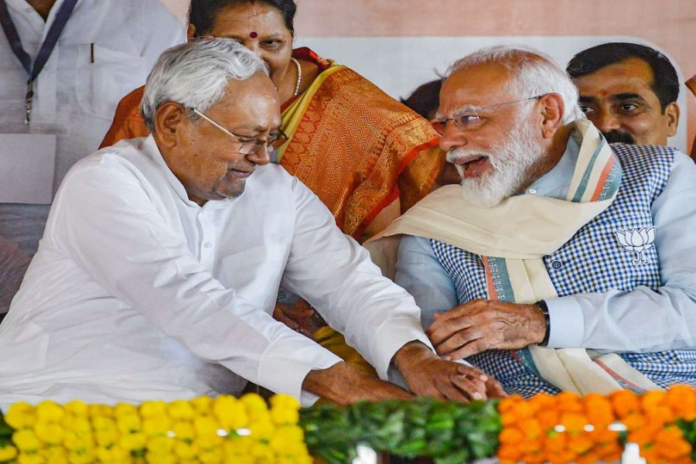The Bharatiya Janata Party (BJP) has suffered a significant setback as it has been unable to secure a majority of 272 members on its own in the Lok Sabha Election 2024.
With 292 seats in Lok Sabha Election 2024, the saffron party-led National Democratic Alliance (NDA) leads the opposition INDIA alliance by 232 seats. In order to achieve its objective, the BJP, which is running for a third term in a row at the Centre, would be looking to its partners.
Chandrababu Naidu of the Telugu Desam Party (TDP) and Nitish Kumar of the Janata Dal (United), or JD(U), are currently the center of attention as they could emerge victorious in the Lok Sabha Election 2024.
Nitish Kumar, the chief minister of Bihar, has a history of flip-flopping, thus the BJP and even the INDIA bloc may try to court him. The BJP-led NDA currently includes the JD(U).
Out of the 40 Lok Sabha seats in Bihar, the BJP and its allies JD(U) are gaining 12 seats apiece, according to the most recent statistics disclosed by the Election Commission of India (ECI).
While Nitish’s party is leading in six seats and has gained six more, the saffron party has secured eight seats and is leading in four. The Lok Janshakti Party (Ram Vilas), an NDA ally, appears to be winning all five of the seats it ran for.
With 494,960 votes, Jitan Ram Manjhi, the secular head of Hindustani Awam Morcha, another NDA ally, defeated the Rashtriya Janata Dal (RJD) nominee by more than one lakh votes to win the Gaya Lok Sabha seat. In the run-up to the Lok Sabha elections, the BJP—which was perceived as the JD(U)’s senior partner—fought on 17 seats, one more than Nitish’s party.
Rashtriya Lok Morcha (RLM) and HAM(S) were each allocated one seat in accordance with the NDA’s seat-sharing formula.
Regarding the INDIA coalition, the Left parties ran candidates for five seats, the Congress for nine, and the RJD for twenty-six.
With the greatest vote share of any party at 22.08 percent, the RJD leads in three seats and has won one.
With respect to vote share, the BJP has twenty.48 percent, while the JD(U) is close to 19%. With a little over 9% of the vote, the Congress has gained three seats. Two seats could be won by the Communist Party of India (Marxist-Leninist) (Liberation) – CPI(ML)(L).
There is merit to the concerns regarding Nitish Kumar’s allegiances.
The seasoned politician has a lengthy history with the NDA. From 1998 to 1999 and again from 2000 to 2004, he held the position of Union minister in Atal Bihari Vajpayee’s government.
But in recent years, he has frequently changed sides.
The prominent JD(U) leader defected from the NDA in 2014 in protest at Narendra Modi’s ascent to national leadership.
Later, he stood alone in the Bihar Lok Sabha elections and won just two seats. In the Bihar Assembly elections of 2015, Nitish formed a coalition with his rival, Lalu Prasad Yadav’s RJD.
After two years, Nitish broke up with its new partner even as they were forming the government.
After the alliance, which also included Ram Vilas Paswan’s Lok Janshakti Party, won 39 of the 40 Lok Sabha seats in 2019. The chief minister of Bihar returned to the NDA.
A year later, the JD(U) won just 43 out of the 243 Assembly constituencies in Bihar, with the saffron party emerging as a senior partner with 74 seats.
Despite the BJP’s more seats, Nitish took oath as the chief minister. However, as he grew “increasingly uncomfortable” with the saffron party, he broke the alliance and joined hands with the RJD in 2022.
In January this year, Nitish Kumar, who is infamous as “Paltu Ram” in Bihar, took a U-turn and returned to the NDA fold.
The move took many by surprise as it was the JD(U) chief who had spearheaded the efforts to form the INDIA coalition. He had approached the Congress and other anti-BJP parties to take on Narendra Modi’s BJP and stop the NDA juggernaut in the 2024 polls.
Nitish’s aspirations to become prime minister are well known. The Bihar chief minister resigned from the alliance despite publicly claiming that he did so due to a standoff over seat-sharing negotiations, as he was not even given the opportunity to be prime minister in the event that the opposition won.
The BJP is on track to win 240 seats in this election, making it the largest party even if it is not gaining a majority on its own. Its supporters are now required to form the government. The JD(U) of Nitish might be crucial in enabling such.
On Tuesday, June 4, Bihar deputy chief minister Samrat Choudhary had reached Nitish’s home in Patna.
Nitish Kumar visited Delhi and spoke with Prime Minister Narendra Modi the day before the Lok Sabha election results were announced. It was called a “courtesy call” by the JD(U). The Opposition INDIA has declared that Nitish is welcome to come back if he so chooses. As the results started to come in, there were also rumors that veteran INDIA bloc leader Sharad Pawar called the chief minister of Bihar.
But earlier on Tuesday, the leader of the Nationalist Congress Party (Sharadchandra Pawar) denied the rumors.
The RJD is hopeful that Nitish and Chandrababu Naidu, whose TDP has won handily both the Assembly and Lok Sabha elections in Andhra Pradesh, can unseat the NDA because both politicians have a



